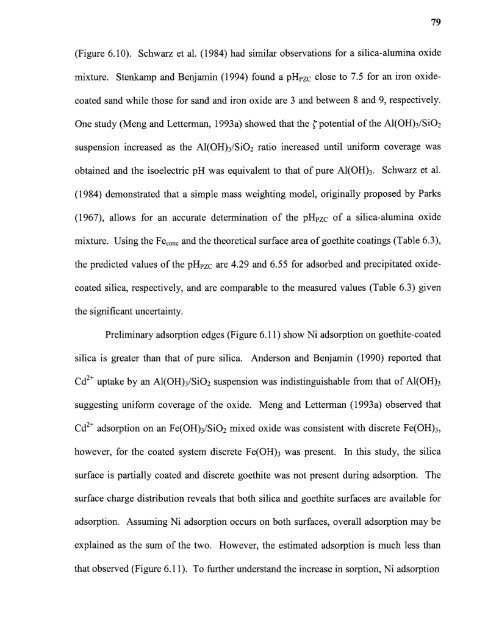Heavy metal adsorption on iron oxide and iron oxide-coated silica ...
Heavy metal adsorption on iron oxide and iron oxide-coated silica ...
Heavy metal adsorption on iron oxide and iron oxide-coated silica ...
You also want an ePaper? Increase the reach of your titles
YUMPU automatically turns print PDFs into web optimized ePapers that Google loves.
79(Figure 6.10). Schwarz et al. (1984) had similar observati<strong>on</strong>s for a <strong>silica</strong>-alumina <strong>oxide</strong>mixture. Stenkamp <strong>and</strong> Benjamin (1994) found a pHpzc close to 7.5 for an ir<strong>on</strong> <strong>oxide</strong><strong>coated</strong>s<strong>and</strong> while those for s<strong>and</strong> <strong>and</strong> ir<strong>on</strong> <strong>oxide</strong> are 3 <strong>and</strong> between 8 <strong>and</strong> 9, respectively.One study (Meng <strong>and</strong> Letterman, 1993a) showed that the potential of the Al(OH)3/Si02suspensi<strong>on</strong> increased as the Al(OH) 3/SiO2 ratio increased until uniform coverage wasobtained <strong>and</strong> the isoelectric pH was equivalent to that of pure Al(OH)3. Schwarz et al.(1984) dem<strong>on</strong>strated that a simple mass weighting model, originally proposed by Parks(1967), allows for an accurate determinati<strong>on</strong> of the pHpzc of a <strong>silica</strong>-alumina <strong>oxide</strong>mixture. Using the Fec<strong>on</strong>c <strong>and</strong> the theoretical surface area of goethite coatings (Table 6.3),the predicted values of the pHpzc are 4.29 <strong>and</strong> 6.55 for adsorbed <strong>and</strong> precipitated <strong>oxide</strong><strong>coated</strong><strong>silica</strong>, respectively, <strong>and</strong> are comparable to the measured values (Table 6.3) giventhe significant uncertainty.Preliminary <str<strong>on</strong>g>adsorpti<strong>on</strong></str<strong>on</strong>g> edges (Figure 6.11) show Ni <str<strong>on</strong>g>adsorpti<strong>on</strong></str<strong>on</strong>g> <strong>on</strong> goethite-<strong>coated</strong><strong>silica</strong> is greater than that of pure <strong>silica</strong>. Anders<strong>on</strong> <strong>and</strong> Benjamin (1990) reported thatCd2+ uptake by an Al(OH)3/SiO2 suspensi<strong>on</strong> was indistinguishable from that of Al(OH)3suggesting uniform coverage of the <strong>oxide</strong>. Meng <strong>and</strong> Letterman (1993a) observed thatCd2+ <str<strong>on</strong>g>adsorpti<strong>on</strong></str<strong>on</strong>g> <strong>on</strong> an Fe(OH)3/SiO2 mixed <strong>oxide</strong> was c<strong>on</strong>sistent with discrete Fe(OH)3,however, for the <strong>coated</strong> system discrete Fe(OH)3 was present. In this study, the <strong>silica</strong>surface is partially <strong>coated</strong> <strong>and</strong> discrete goethite was not present during <str<strong>on</strong>g>adsorpti<strong>on</strong></str<strong>on</strong>g>. Thesurface charge distributi<strong>on</strong> reveals that both <strong>silica</strong> <strong>and</strong> goethite surfaces are available for<str<strong>on</strong>g>adsorpti<strong>on</strong></str<strong>on</strong>g>. Assuming Ni <str<strong>on</strong>g>adsorpti<strong>on</strong></str<strong>on</strong>g> occurs <strong>on</strong> both surfaces, overall <str<strong>on</strong>g>adsorpti<strong>on</strong></str<strong>on</strong>g> may beexplained as the sum of the two. However, the estimated <str<strong>on</strong>g>adsorpti<strong>on</strong></str<strong>on</strong>g> is much less thanthat observed (Figure 6.11). To further underst<strong>and</strong> the increase in sorpti<strong>on</strong>, Ni <str<strong>on</strong>g>adsorpti<strong>on</strong></str<strong>on</strong>g>
















